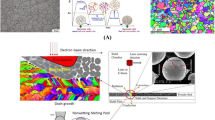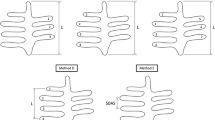Abstract
Bonded discrete element method (DEM) models utilize networks of bonds between discrete particles to simulate continuum behaviors of real materials, most notably large deformations and failure which are difficult to simulate with mesh-based methods. However, the process of calibrating the bond parameters to produce specific macroscale properties remains an active area of research. Current calibration methods typically demonstrate the applicability of calibrations on the geometry they were created from. Our research utilizes an energy-based method to produce calibrations for monodisperse randomly packed bonded particles without running simulations. These calibrations are then utilized to simulate networks of bonded particles that vary from the calibration set in one of three ways: (1) number of particles; (2) aspect ratio; and (3) cross section shape. This work quantifies the standard deviation in the mean Young’s modulus and Poisson’s ratio produced by a general DEM calibration for randomly packed bonded particle specimens if the coordination number, particle diameter, shape, or aspect ratio is varied.



























Similar content being viewed by others
References
André D, Iordanoff I, Charles Jl, Néauport J (2012) Discrete element method to simulate continuous material by using the cohesive beam model. Comput Methods Appl Mech Eng 213:113–125. https://doi.org/10.1016/j.cma.2011.12.002
Berger KJ, Hrenya CM (2014) Challenges of DEM: II. Wide particle size distributions. Powder Technol 264:627–633. https://doi.org/10.1016/j.powtec.2014.04.096
Chang CS, Liao CL (1990) Constitutive relation for a particulate medium with the effect of particle rotation. Int J Solids Struct 26(4):437–453. https://doi.org/10.1016/0020-7683(90)90067-6
Clemmer JT, Long KN, Brown JA (2023) Exploring pressure-dependent inelastic deformation and failure in bonded granular composites: an energetic materials perspective. Mech Mater. https://doi.org/10.1016/j.mechmat.2023.104693
Cundall PA, Strack OD (1979) A discrete numerical model for granular assemblies. Geotechnique 29(1):47–65. https://doi.org/10.1680/geot.1979.29.1.47
Estay D, Chacana F, Ibarra J, Pérez L, Lascano S (2017) Bond calibration method for young’s modulus determination in the discrete element method framework. Granul Matter 19:1–7. https://doi.org/10.1007/s10035-017-0734-5
Girardot J, Pruliere E (2021) Elastic calibration of a discrete domain using a proper generalized decomposition. Comput Part Mech 8:993–1000. https://doi.org/10.1007/s40571-020-00385-8
Griffiths D, Mustoe GG (2001) Modelling of elastic continua using a grillage of structural elements based on discrete element concepts. Int J Numer Meth Eng 50(7):1759–1775. https://doi.org/10.1002/nme.99
Guo J, Xu G, Jing H, Kuang T (2013) Fast determination of meso-level mechanical parameters of PFC models. Int J Min Sci Technol 23(1):157–162. https://doi.org/10.1016/j.ijmst.2013.03.007
Hanley KJ, O’sullivan C, Oliveira JC, Cronin K, Byrne EP (2011) Application of Taguchi methods to DEM calibration of bonded agglomerates. Powder Technol 210(3):230–240. https://doi.org/10.1016/j.powtec.2011.03.023
Hentz S, Daudeville L, Donzé FV (2004) Identification and validation of a discrete element model for concrete. J Eng Mech 130(6):709–719. https://doi.org/10.1061/(ASCE)0733-9399(2004)130:6(709)
Ibarra J, Estay D, Pacheco A, Guzmán L, Barraza R, Chacana F, Hernández C (2022) Bond calibration method for macroparameters using the discrete element method framework. Eng Fract Mech 262:108223. https://doi.org/10.1016/j.engfracmech.2021.108223
Jarolin K, Dosta M (2021) Linearization-based methods for the calibration of bonded-particle models. Comput Part Mech 8(3):511–523. https://doi.org/10.1007/s40571-020-00348-z
Ku Q, Zhao J, Mollon G, Zhao S (2023) Compaction of highly deformable cohesive granular powders. Powder Technol. https://doi.org/10.1016/j.powtec.2023.118455
Leclerc W (2017) Discrete element method to simulate the elastic behavior of 3D heterogeneous continuous media. Int J Solids Struct 121:86–102. https://doi.org/10.1016/j.ijsolstr.2017.05.018
Leclerc W (2019) Effect of packing characteristics on the simulation of elasticity and brittle fracture by the cohesive discrete element method. Granul Matter 21(2):17. https://doi.org/10.1007/s10035-019-0877-7
Liao CL, Chang TP, Young DH, Chang CS (1997) Stress-strain relationship for granular materials based on the hypothesis of best fit. Int J Solids Struct 34(31–32):4087–4100. https://doi.org/10.1016/S0020-7683(97)00015-2
Lochmann K, Oger L, Stoyan D (2006) Statistical analysis of random sphere packings with variable radius distribution. Solid State Sci 8(12):1397–1413. https://doi.org/10.1016/j.solidstatesciences.2006.07.011
Lubachevsky BD, Stillinger FH (1990) Geometric properties of random disk packings. J Stat Phys 60:561–583. https://doi.org/10.1007/BF01025983
Meurer A, Smith CP, Paprocki M, Čertík O, Kirpichev SB, Rocklin M, Kumar A, Ivanov S, Moore JK, Singh S, Rathnayake T, Vig S, Granger BE, Muller RP, Bonazzi F, Gupta H, Vats S, Johansson F, Pedregosa F, Curry MJ, Terrel AR, Roučka v, Saboo A, Fernando I, Kulal S, Cimrman R, Scopatz A (2017) Sympy: symbolic computing in python. PeerJ Comput Sci 3:e103. https://doi.org/10.7717/peerj-cs.103
Nguyen TT, André D, Huger M (2019) Analytic laws for direct calibration of discrete element modeling of brittle elastic media using cohesive beam model. Comput Part Mech 6(3):393–409. https://doi.org/10.1007/s40571-018-00221-0
Plimpton S (1995) Fast parallel algorithms for short-range molecular dynamics. J Comput Phys 117(1):1–19. https://doi.org/10.1006/jcph.1995.1039
Potyondy D (2012) A flat-jointed bonded-particle material for hard rock. In: 46th US rock mechanics/geomechanics symposium. OnePetro
Potyondy DO, Cundall P (2004) A bonded-particle model for rock. Int J Rock Mech Min Sci 41(8):1329–1364. https://doi.org/10.1016/j.ijrmms.2004.09.011
Qu T, Feng Y, Wang M, Jiang S (2020) Calibration of parallel bond parameters in bonded particle models via physics-informed adaptive moment optimisation. Powder Technol 366:527–536. https://doi.org/10.1016/j.powtec.2020.02.077
Qu T, Feng Y, Zhao J (2022) A strain energy-based elastic parameter calibration method for lattice/bonded particle modelling of solid materials. Powder Technol 410:117860. https://doi.org/10.1016/j.powtec.2022.117860
Redaelli I, di Prisco C (2019) Three dimensional steady-state locus for dry monodisperse granular materials: dem numerical results and theoretical modelling. Int J Numer Anal Methods Geomech 43(16):2525–2550. https://doi.org/10.1002/nag.2985
Schramm M, Tekeste MZ (2022) Wheat straw direct shear simulation using discrete element method of fibrous bonded model. Biosyst Eng 213:1–12. https://doi.org/10.1016/j.biosystemseng.2021.10.010
Scott G, Kilgour D (1969) The density of random close packing of spheres. J Phys D Appl Phys 2(6):863. https://doi.org/10.1088/0022-3727/2/6/311
Silbert LE (2010) Jamming of frictional spheres and random loose packing. Soft Matter 6(13):2918–2924
Spettl A, Bachstein S, Dosta M, Goslinska M, Heinrich S, Schmidt V (2016) Bonded-particle extraction and stochastic modeling of internal agglomerate structures. Adv Powder Technol 27(4):1761–1774. https://doi.org/10.1016/j.apt.2016.06.007
Thompson AP, Aktulga HM, Berger R, Bolintineanu DS, Brown WM, Crozier PS, in’t Veld PJ, Kohlmeyer A, Moore SG, Nguyen TD et al (2022) Lammps-a flexible simulation tool for particle-based materials modeling at the atomic, meso, and continuum scales. Comput Phys Commun 271:108171. https://doi.org/10.1016/j.cpc.2021.108171
Utili S, Nova R (2008) Dem analysis of bonded granular geomaterials. Int J Numer Anal Methods Geomech 32(17):1997–2031. https://doi.org/10.1002/nag.728
Vassaux M, Oliver-Leblond C, Richard B, Ragueneau F (2016) Beam-particle approach to model cracking and energy dissipation in concrete: identification strategy and validation. Cement Concr Compos 70:1–14. https://doi.org/10.1016/j.cemconcomp.2016.03.011
Virtanen P, Gommers R, Oliphant TE, Haberland M, Reddy T, Cournapeau D, Burovski E, Peterson P, Weckesser W, Bright J et al (2020) Scipy 1.0: fundamental algorithms for scientific computing in python. Nat Methods 17(3):261–272. https://doi.org/10.1038/s41592-020-0772-5
Wang Y (2009) A new algorithm to model the dynamics of 3-D bonded rigid bodies with rotations. Acta Geotech 4(2):117–127. https://doi.org/10.1007/s11440-008-0072-1
Wang Y, Abe S, Latham S, Mora P (2006) Implementation of particle-scale rotation in the 3-D lattice solid model. In: Yin XC, Mora P, Donnellan A, Matsu’ura M (eds) Computational earthquake physics: simulations, analysis and infrastructure part I. Birkhäuser Basel, Basel, pp 1769–1785
Wang Y, Mora P (2008) Macroscopic elastic properties of regular lattices. J Mech Phys Solids 56(12):3459–3474. https://doi.org/10.1016/j.jmps.2008.08.011
Wang Y, Mora P (2009) The ESyS_particle: a new 3-D discrete element model with single particle rotation. Springer Berlin Heidelberg, Berlin, Heidelberg, pp 183–228. https://doi.org/10.1007/978-3-540-85879-9_6
Wang Y, Tonon F (2010) Calibration of a discrete element model for intact rock up to its peak strength. Int J Numer Anal Methods Geomech 34(5):447–469. https://doi.org/10.1002/nag.811
Wittel FK, Carmona HA, Kun F, Herrmann HJ (2008) Mechanisms in impact fragmentation. Int J Fract 154:105–117. https://doi.org/10.1007/s10704-008-9267-6
Yoon J (2007) Application of experimental design and optimization to PFC model calibration in uniaxial compression simulation. Int J Rock Mech Min Sci 44(6):871–889. https://doi.org/10.1016/j.ijrmms.2007.01.004
Zhou Z, Bai S, Chu K, Li J, Sun J, Wang M, Sun Y, Li M, Liu Y (2022) Calibration of DEM macro and micro parameters via XGBoost method. Granul Matter 24(4):106. https://doi.org/10.1007/s10035-022-01264-0
Acknowledgements
The authors gratefully acknowledge helpful discussions and careful review from Joel Clemmer and Dan Bolintineanu of Sandia National Laboratories. Portions of this research were conducted with high performance research computing resources provided by Texas A &M University (https://hprc.tamu.edu). This work was partially supported by the Laboratory Directed Research and Development program at Sandia National Laboratories, a multimission laboratory managed and operated by National Technology and Engineering Solutions of Sandia LLC, a wholly owned subsidiary of Honeywell International Inc. for the U.S. Department of Energy’s National Nuclear Security Administration under contract DE-NA0003525.
Author information
Authors and Affiliations
Corresponding author
Ethics declarations
Conflict of interest
The authors declare that they have no conflict of interest.
Additional information
Publisher's Note
Springer Nature remains neutral with regard to jurisdictional claims in published maps and institutional affiliations.
Appendix
Appendix
See Tables 3, 4, 5, 6, 7, 8, 9, 10, 11, 12, 13, 14, 15, 16, and 17.
Rights and permissions
Springer Nature or its licensor (e.g. a society or other partner) holds exclusive rights to this article under a publishing agreement with the author(s) or other rightsholder(s); author self-archiving of the accepted manuscript version of this article is solely governed by the terms of such publishing agreement and applicable law.
About this article
Cite this article
Martin, S., Cooper, M.A. The role of randomly packed particles on macroscopic elastic bonded grain properties. Comp. Part. Mech. (2024). https://doi.org/10.1007/s40571-023-00704-9
Received:
Revised:
Accepted:
Published:
DOI: https://doi.org/10.1007/s40571-023-00704-9




